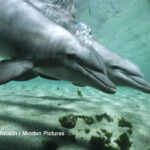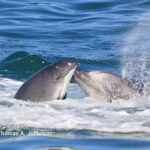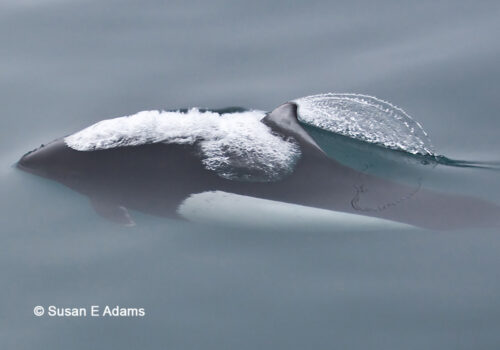
Bottlenose Dolphin
January 15, 2025
Harbor Porpoise
January 15, 2025 DALL’S PORPOISE
DALL’S PORPOISE
Phocoenoides dalli
(True, 1885)
DERIVATION: from the Latin or Greek phocaena for porpoise and from the Greek oides for like.
Often called the “spray” porpoise, Dall’s porpoises are the fastest of all the porpoises. They can reach speeds of up to 30 knots. Dall’s do not jump very often, but when they are swimming at speed, its head and back produce a spray called a “rooster tail.” It loves to bow-ride on the waves created by fast-moving watercraft.
They have distinctive black and white coloring with a striking white region on the belly, and a triangular dorsal fin that is often partly or completely grayish white. They also have pointed flippers and broad flukes. The flukes are small and pointed at the tip with a small center notch. The head is relatively small and lacks a well-defined beak, which is one way to distinguish porpoises from their dolphin cousins who exhibit a well-defined beak. Porpoises are also generally smaller than dolphins. Eye color is unusual in cetaceans but the Dall’s is an exception. Its eye has been described as having a black or dark blue iris and a deep, iridescent blue-green pupil.
Dall’s were named after an American naturalist, W. H. Dall, who was the first person to identify the species.
Dall’s porpoises weigh up to 350 pounds and reach lengths of up to seven feet. They are extremely stocky and powerful. As with all species of porpoises, its teeth are small and spade shaped while dolphins conical-shaped teeth. Dall’s have 19-23 very small teeth in each side of the upper jaw, and about 20-24 teeth in each side of its lower jaw which extends a little beyond the upper.
Males reach sexual maturity at 8 years; females at 6.5 years. The gestation period for a Dall’s porpoise is 11.4 months, and calves are usually born in the summer months and measure three to four feet in length. Births occur approximately every three years.
They have a varied diet and feed on squid, jack mackerel, hake, capelin crustaceans and herring. It consumes 28 to 30 pounds of food each day and mostly feeds at night.
When it swims and rolls at the surface, it is often mistaken for its small gray-brown cousin, the harbor porpoise.
Dall’s are generally found in the North Pacific and South Bering Sea. Groups of 2-20 have been seen, although there have been sightings of groups of several thousand.
Catches numbering in the tens of thousands have been reported for a northern Japan harpoon fishery. In 1994, 15,947 Dall’s were taken. In 1988, over 40,000 were taken and that number represents one-third of the population that migrated through the fishing area annually. In the 1960s,10,000-20,000 Dall’s porpoises that became entangled in gill nets used in high-seas salmon fisheries were killed and discarded.
A few Dall’s porpoises have been held in captivity, but the species’ fragility in captivity prevents them from being a profitable display animal for marine park aquaria.
The only natural enemies of Dall’s, other than man, are killer whales and occasionally sharks.
Pollution of all of the world’s seas and oceans, continue to endanger the Dall’s and all marine life.

